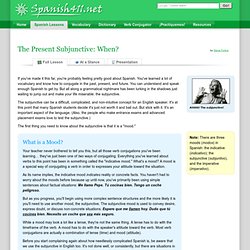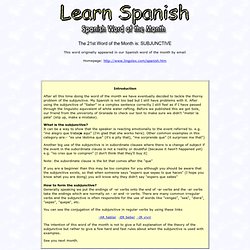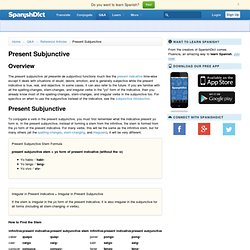

The Present Subjunctive: When? - Spanish411. If you've made it this far, you're probably feeling pretty good about Spanish.

You've learned a lot of vocabulary and know how to conjugate in the past, present, and future. You can understand and speak enough Spanish to get by. But all along a grammatical nightmare has been lurking in the shadows just waiting to jump out and make your life miserable: the subjunctive. The subjunctive can be a difficult, complicated, and non-intuitive concept for an English speaker. Subjunctive: Spanish Grammar Practice. Practice quiz. The Subjunctive: A Quiz - Spanish Language. Present Subjunctive Verb Conjugation Chart.
Present Subjunctive in Spanish (Forms) Learn Spanish 3.1 - When to Use the Subjunctive? W.E.I.R.D.O.! (part 1) Spanish grammar lesson - Subjunctive - Explanation. Introduction After all this time doing the word of the month we have eventually decided to tackle the thorny problem of the subjunctive.

My Spanish is not too bad but I still have problems with it. After using the subjunctive of "Saber" in a complex sentence correctly I still feel as if I have passed through the linguistic equivalent of white water rafting. Before we published this we got Sole, our friend from the university of Granada to check our text to make sure we didn't "meter la pata" (slip up, make a mistake). What is the subjunctive? Another big use of the subjunctive is in subordinate clauses where there is a change of subject if the event in the subordinate clause is not a reality or doubtful (because it hasn't happened yet) e.g.
Note: the subordinate clause is the bit that comes after the "que" How to form the subjunctive? You can see the conjugation of the subjunctive in regular verbs by using these links -AR hablar -ER beber -IR vivir See you next month. Subjunctive vs. Indicative - WEIRDO vs. SPOCK. Overview The subjunctive is one of the three moods in Spanish, the other two being the indicative (actions, events, facts) and the imperative (commands).

Moods reflect how the speaker feels about an action while a tense refers to when an action takes place. The subjunctive mood is used to express desires, doubts, the unknown, the abstract, and emotions, which is the opposite of the indicative mood which is used to express actions, events, and states that are believed to be true and concrete. Most of the tenses you have learned so far have been in the indicative mood; however, the subjunctive mood includes many of the same verb tenses, but not all, in three different time periods: General Rules for Indicative vs. . - In general, the Indicative mood is objective and certain. It is used to talk about actions, events, or states that are believed to be facts or true. . - In general, the subjunctive mood is subjective and possible (but not certain).
Parts of a Subjunctive Phrase 1. 2. 3. Spanish II: The Present Subjunctive. Present Subjunctive. Overview The present subjunctive (el presente de subjuntivo) functions much like the present indicative time-wise except it deals with situations of doubt, desire, emotion, and is generally subjective while the present indicative is true, real, and objective.

In some cases, it can also refer to the future. If you are familiar with all the spelling-changes, stem-changes, and irregular verbs in the "yo" form of the indicative, then you already know most of the spelling-changes, stem-changes, and irregular verbs in the subjunctive too. For specifics on when to use the subjunctive instead of the indicative, see the subjunctive introduction.
Present Subjunctive To conjugate a verb in the present subjunctive, you must first remember what the indicative present yo form is.